This Guild X-350B is a near-exact replica of the Epiphone Zephyr Emperor Regent.
Here’s the tale of how the now-Gibson-owned Epiphone company came to be, and its unexpected connection to the birth of this Guild model.
When life gives you lemons, you could make lemonade, but sometimes it’s just too much darn trouble. You don’t have enough sugar at home. You have a paper cut, and nothing is worse than citrus on a paper cut. You might just choose to ditch the lemons and cut your losses.
This gorgeous 1958 Guild X-350B came through our doors at Fanny’s House of Music and told us a sweeping tale of sour times and sweet times, taking us all the way from Turkey to New York. This is the story of how Guild picked up Epiphone’s lemons and made some lemonade.
In 1873, a 12-year-old Greek boy named Anastasios Stathopoulo, who had just moved with his family to İzmir, Turkey, began acquiring woodworking skills by watching his father, a lumber merchant, at work. Anastasios, however, was much more interested in the local folk music scene than in carrying on the family business, and in 1890, he started his own musical instrument manufacturing business. Then, three years later, he and his wife Marianthe welcomed their first child, Epaminondas (“Epi,” for short), into their young family.
Ethnic tensions in Turkey forced the Stathopoulo family to move to the United States in the early 1900s. Anastasios set up shop in Manhattan and became very successful, and little Epi worked alongside his father until Anastasios died of cancer in 1915. It was then Epi’s time to take over.
Marianthe died in the early ’20s. As mandolins were becoming less popular, Epi made the savvy decision to shift the company’s focus to banjos. Eventually, he changed the name of the company from the House of Stathopoulo to Epiphone, combining his nickname with the Greek word for sound: “phone.” Epiphone’s move to banjos proved prescient, and they rocketed ahead of their primary competitor, Gibson.
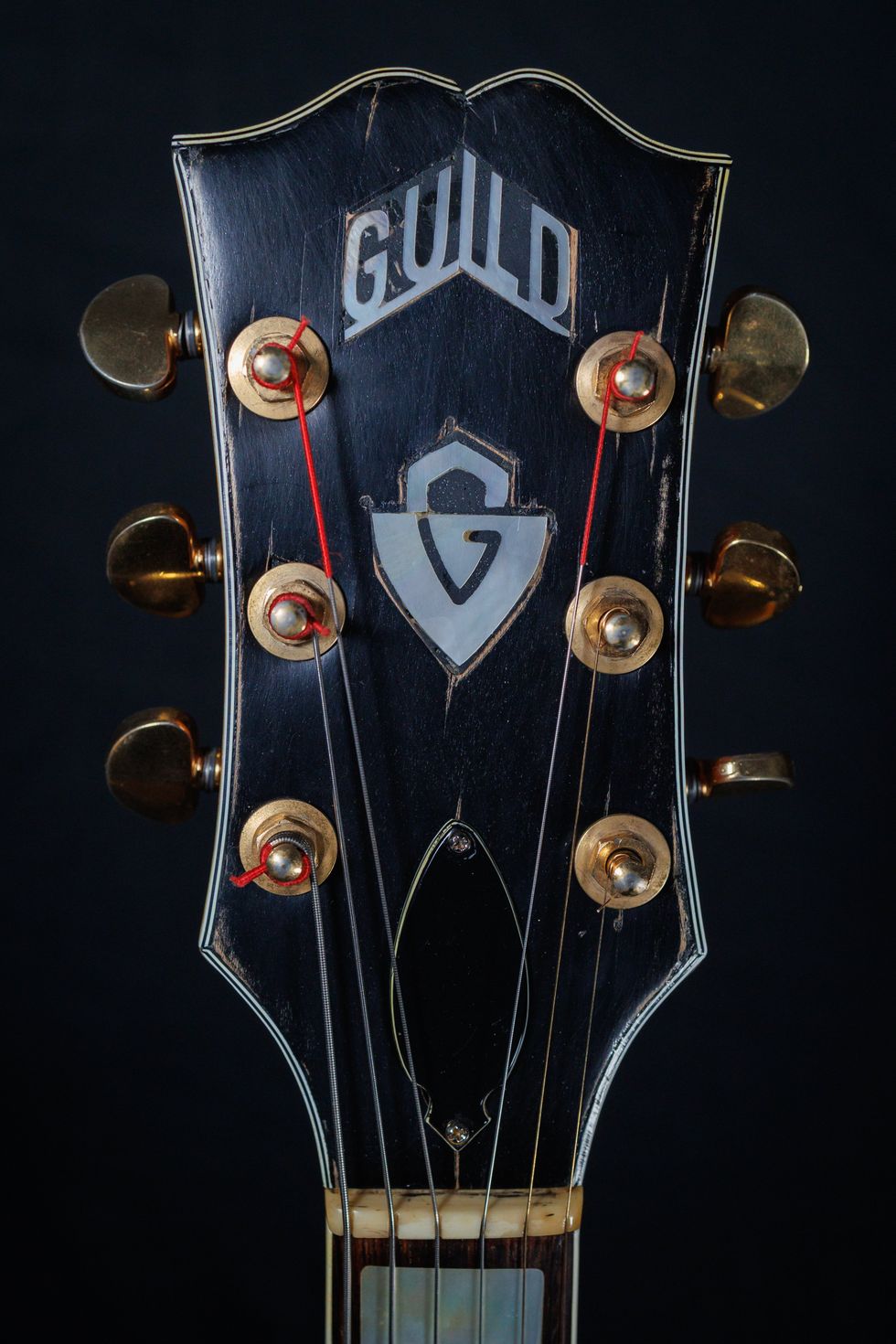
Following Epiphone’s move from NYC to Philadelphia in 1953, several employees began working for the Guild Guitar Company.
Gibson beat Epiphone to the burgeoning guitar market, which touched off an arms race of sorts between the two companies. In 1931, Epiphone tried to pull ahead by introducing their Masterbilt line, featuring guitars that were 3/8" wider than their Gibson counterparts. Gibson followed that up with guitars that were nearly 3 1/2" wider than the Masterbilts, and Epiphone followed that up with a guitar called the Emperor, that was a 1/2" wider still! Competition between the two companies raged on, and Epiphone’s growth would likely have continued unabated if not for the production restrictions of World War II, and the death of Epaminondas in 1943.
Epi’s brothers took control of the company and tried to revamp its offerings with more electric instruments. They gave the Emperor a pickup, and it became the Zephyr Emperor (with the word “Regent” added to the model if it had a cutaway), featuring a cool push-button pickup selector. Unfortunately, this top-of-the-line instrument would be the last hurrah of the storied company, as Epiphone’s finances were shaky, and Epi’s younger brothers proved to not be as gifted in promotion and organization as he had been.
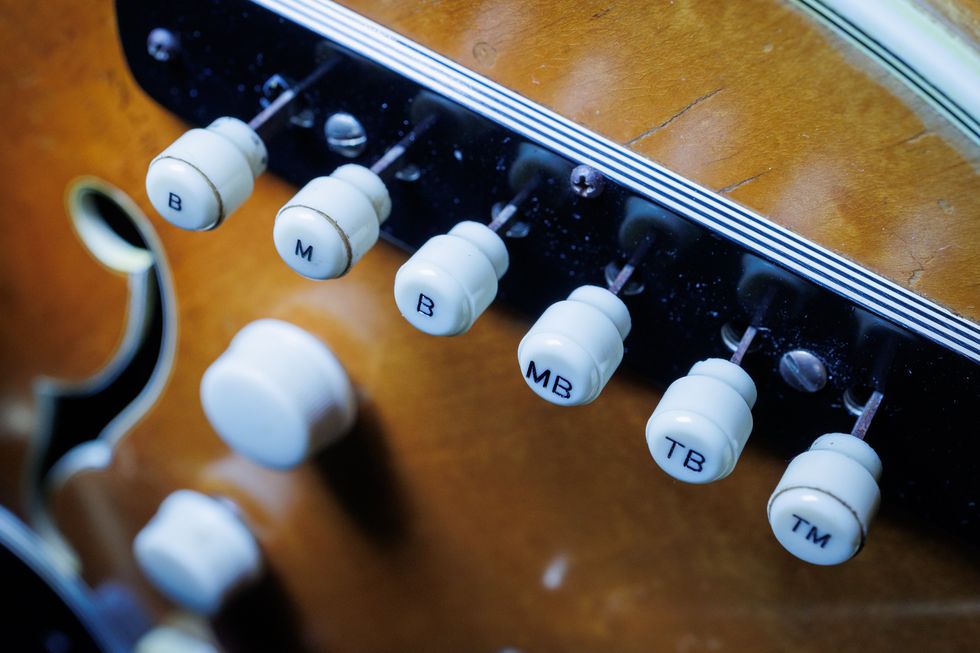
One distinguishing feature on this model and its Epiphone counterpart is its unique push-button pickup selector.
Epiphone’s deteriorating relationship with unions led to a four-month strike and the company moved production to Philadelphia in 1953. But many of the craftsmen chose not to leave New York, and some had already begun working for the nascent Guild Guitar Company, bringing their ideas and designs with them. Eventually, in 1957, Epiphone was sold to Gibson.
Our 1958 Guild X-350B is a near-exact copy of the Epiphone Zephyr Emperor Regent with its three pickups, two knobs, and unique push-button pickup selector that reminds this author of the Chrysler push-button automatic transmissions from the mid ’50s. This is the rare blonde-finished version (hence the “B” in the model name), and behind the 60 years of buckle rash is some beautifully figured maple on the back and sides.
Speaking of buckle rash, sometimes you can just tell that a vintage guitar was very well-loved. This Guild is one of those. The edges of the neck are perfectly rounded, the way only years of playing can achieve, like a piece of glass that’s been rolling around in the ocean for a while and all the corners have rubbed off. Much of the finish on the back of the neck is worn away, and playing this guitar is a delightfully soft experience, sort of like a hug from an old friend.
“Epiphone’s move to banjos proved prescient, and they rocketed ahead of their primary competitor, Gibson.”
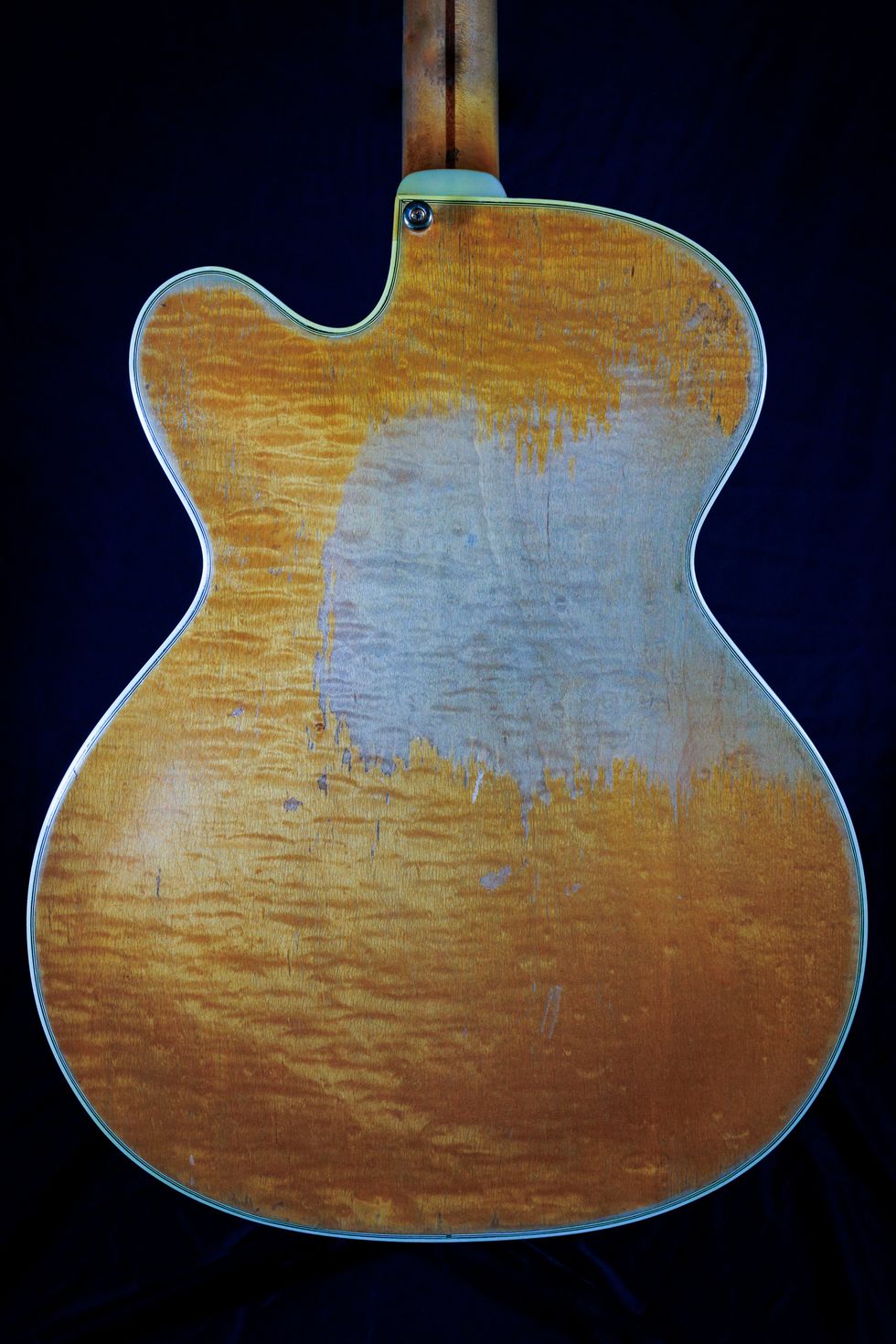
Especially because of the “buckle rash” on the guitar’s back, a sign of heavy use, our columnist deems it very well-loved by its prior owner(s).
Life handed lemons to many of the folks in this story. The Stathopoulo family had to leave their home in Turkey and start a new life in the United States. The employees at Epiphone had to decide whether to move to Philadelphia with their employer or try to find new work in New York. Their collective choices led to this beautiful guitar time-traveling 66 years to our shop, where pretty soon someone will find it as refreshing as a cold glass of lemonade in the summer, and take it home to enjoy for the next 66 years.
Sources: Epiphone.com, “The Epiphone Zephyr Emperor Regent as told by Walter Carter” by Carter Vintage Guitars on YouTube, Gruhn’s Guide to Vintage Guitars by Walter Carter and George Gruhn.
At the time this Jazzmaster was sold, a blonde finish was an unusual alternative on the model to the more typical sunburst.
The famous Jazzmaster bucked conventional Fender design norms at the time it was released, as well as expectations of whom it would appeal to.
Even though the Fender Telecaster and Stratocaster were selling well to those playing country, blues, and rock ’n’ roll, Leo Fender wanted to design a guitar that appealed to serious jazz musicians. Fender introduced this guitar in mid 1958. It was optimistically named the Jazzmaster, and while it was quickly embraced by famed, jazz-informed country session player Harold Bradley, its newly designed mellower pickups and floating vibrato still did not appeal to highbrow jazz musicians. The new model was, however, embraced by young players, like the instrumental group called the Ventures, who played a new type of music eventually known as “surf.”
During the model’s first decade, Johnny Cash guitarist Luther Perkins, Jimi Hendrix, Pete Townshend, and Bob Dylan were all seen wielding Jazzmasters. Today, amid the offset-body guitar renaissance, those using the model include J Mascis, Radiohead’s Thom Yorke, My Bloody Valentine’s Kevin Shields, and Slipknot’s Jim Root.
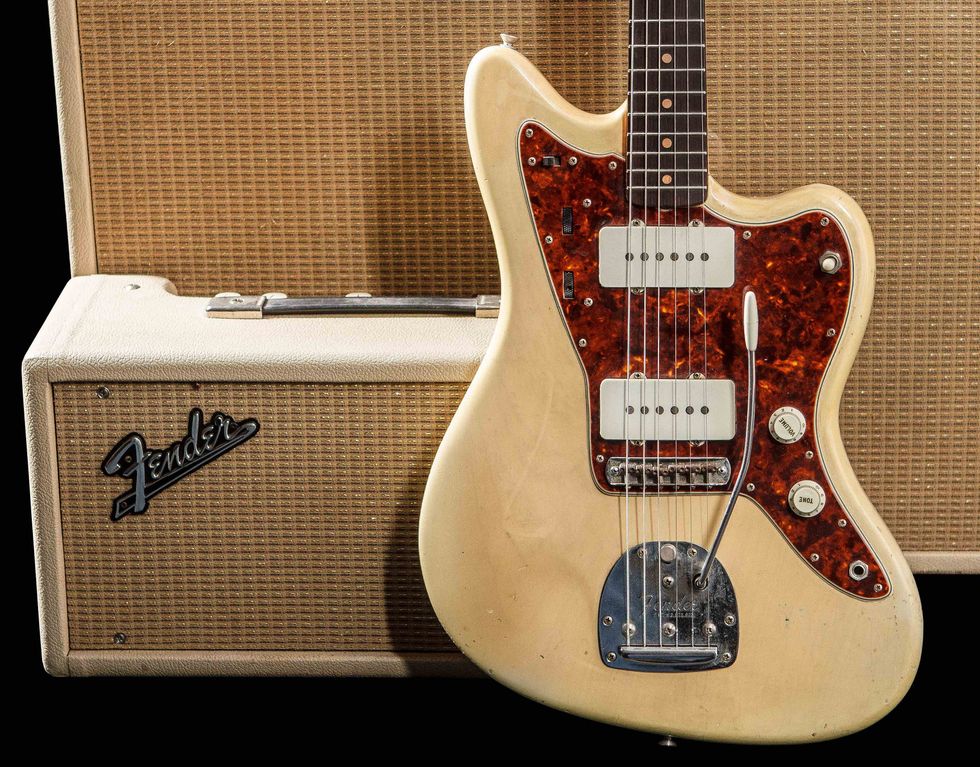
Features such as the guitar’s floating vibrato arm ended up appealing to surf rockers such as the Ventures.
The 1962–’63 Fender catalog describes the instrument’s special features: “This remarkable guitar incorporates all the well-known Fender developments, including the new ‘off-set’ body design, smooth tremolo action, plus, separate rhythm and lead tone circuits. In addition, it offers a comfort-contoured body and truss-rod reinforced fast-action neck with a rosewood fingerboard for effortless playing and faster playing technique. Every convenience is provided, including the tremolo lock, adjustable master bridge channel with individually adjustable two-way bridges and completely adjustable high-fidelity pickups.”
The January 1963 Jazzmaster pictured has most of the features common to that year, including a 25 1/2"-scale maple neck with a round laminated rosewood fretboard (which replaced the flat laminated “slab” board by late ’62). This neck may be one of the last with wide-spaced clay dots at the 12th fret, as the spacing became slightly narrower in early 1963. This guitar sports a see-through blonde finish over an ash body. While this was a standard finish for a Telecaster, a Jazzmaster usually came with a sunburst finish over an alder body. This custom finish cost an extra $17.47.
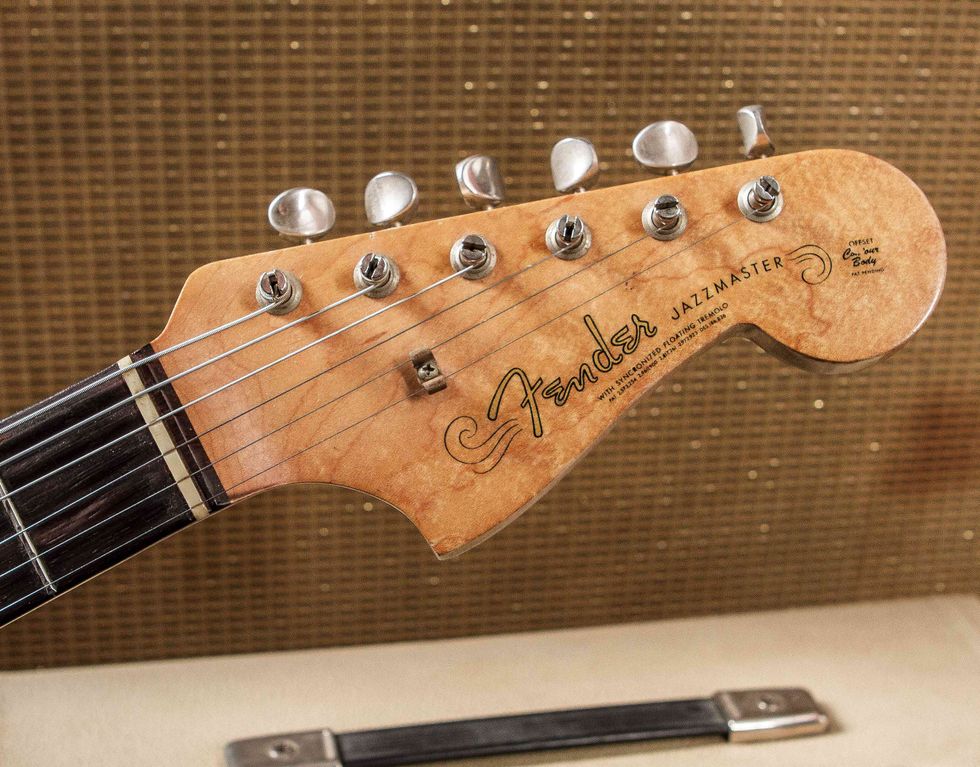
The current list price for a vintage Jazzmaster with a blonde finish in excellent, original condition is $10,000.
One of the Jazzmaster’s appeals was its then-unconventional circuitry. At the upper bout, there is a switch for rhythm (dark) and lead (bright), separate volume and tone controls for the rhythm settings, and a master volume and tone along with a 3-way switch.
The 1963 list price for a Jazzmaster with a blonde finish was $366.97. The current value for one in excellent, all-original condition is $10,000.
“It was optimistically named the Jazzmaster, but its newly designed mellower pickups and floating vibrato still did not appeal to highbrow jazz musicians.”
The rig behind the Jazzmaster consists of a 1964 Showman head and cabinet, and a 1964 Fender Reverb Unit, all in matching white Tolex. The Showman head has four 6L6 power tubes that push 80 watts through the cabinet’s 15 JBL speaker. The amp has a normal channel with a bright switch, volume, treble, and bass controls. The vibrato channel has a bright switch, volume, treble, middle, bass, speed, and intensity controls. The Reverb Unit has a dwell, mixer, and tone control, and would be plugged in between the guitar and amp for a lush effect.
The original price for a Showman Amp piggyback, with a 15" JBL, was $600. The current value is $2,500. The original price for a Fender Reverb Unit was $129.50. The current value is $1,500.
Sources for this article include Fender: The Sound Heard ’Round the World by Richard R. Smith, Fender Amps: The First Fifty Years by John Teagle and John Sprung, and the 1962–’63 Fender Catalog.This rare 1941 Kay Carson Robison guitar bears traces of multiple repairs done over time.
If you were interested in playing guitar in the 1930s and 1940s, you were probably a fan of singing cowboys. The old Western teleplays on the radio were vehicles for marketing all kinds of products, like toys, costumes, and, of course, guitars!
Today, we’re familiar with the names Gene Autry and Roy Rogers, but back then, any cowboy fan would have also known Carson Robison. Robison was born in 1890 to a champion-fiddler father and a dance-caller mother. In the 1920s, he was one of the first cowboy singers to become a radio performer, famous for his virtuosic whistling ability. He wrote over 300 songs in his career, including his 1948 hit, “Life Gets Tee-Jus, Don’t It,” featured in episode 123 of the original Muppet Show, which is how I first heard of him.
The Montgomery Ward catalog offered Carson Robison-model guitars from 1930 through 1941. The 6-string changed a little every couple of years, ultimately ending up with eight different variations. The subject of this month’s column is the rare eighth variation, also called Model 964, made only for a short time in the fall of 1941 by the Kay Musical Instrument Company. According to the original catalog, it has a “Selected Spruce Top” and mahogany back and sides, and the top is solid wood as far as we can tell. The back and sides, however, are made of a few disparate pieces. The body on this guitar was shrunk from the previous grand auditorium size (41 1/4 x 16 1/4) to a smaller grand concert size (39 1/2 x 14), and it has a distinctive oval-shaped soundhole. Like the other Carson Robison guitars, it has his signature painted on the body, below the bridge.
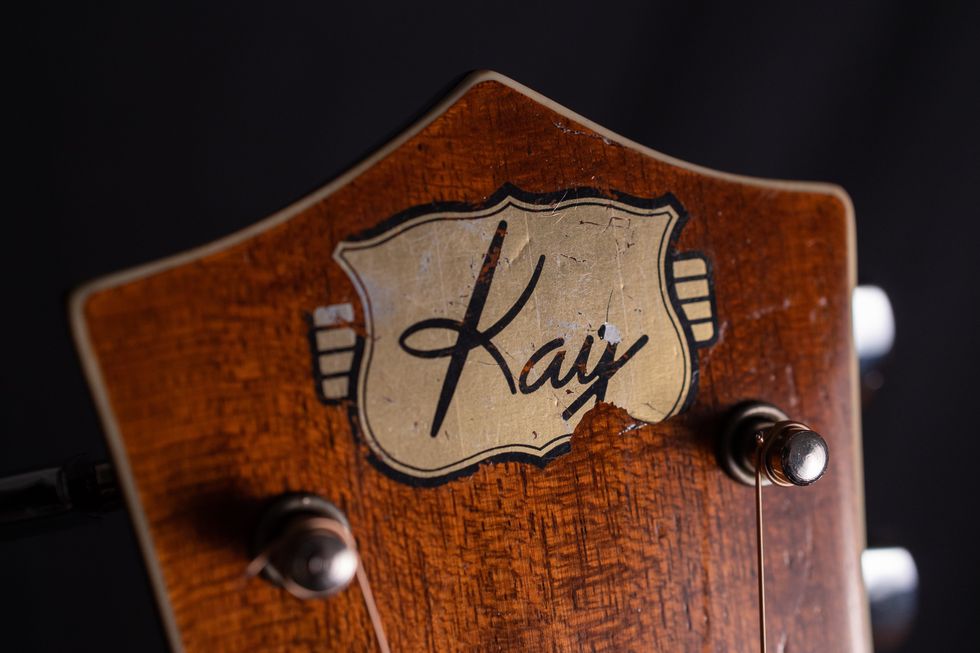
Also known as Model 964, this version of the Carson Robison is the eighth variation on the original.
Photo by Madison Thorn
This particular example has had a number of repairs over the years. The tuners are newer, and it’s had a bone saddle installed. Its amber sunburst finish has some overspray, likely covering a past repair. It’s also had a refret and a neck reset, and it’s playing better than ever. The neck has a chunky V-shape, which is typical for these early-20th century guitars that were made before truss rods. It’s got a bunch of dings, finish-checking, and evidence of past repairs, which I think adds character. I like to imagine this guitar had a dynamic early life, being played and loved by some rowdy siblings.
While researching this model, we at Fanny’s House of Music in Nashville came across a clipping of the 1941 Montgomery Ward catalog this guitar was listed in and found something curious cut off on the left side of the page. Featured right next to the Carson Robison guitar was a 6-string bearing the name of Louise Massey. Could it be that not all singing cowboys were boys? I found myself in the throes of a deep Google search when our old friend Frank Hall came to the rescue.
“I like to imagine this guitar had a dynamic early life, being played and loved by some rowdy siblings.”
Frank Hall was a fixture here in Nashville. He was a member of the Serendipity Singers, a folk group that performed at Woodstock. He was also a lifelong guitar collector and one of the world’s preeminent “catalog guitar” experts. He came into Fanny’s often to tell us stories about these old guitars, and when we were lucky, he’d play us a song. Frank passed away in early 2021, but he left us with a wealth of knowledge, and importantly, for our purposes today, a tome called Cowboy Guitars by Steve Evans and Ron Middlebrook.
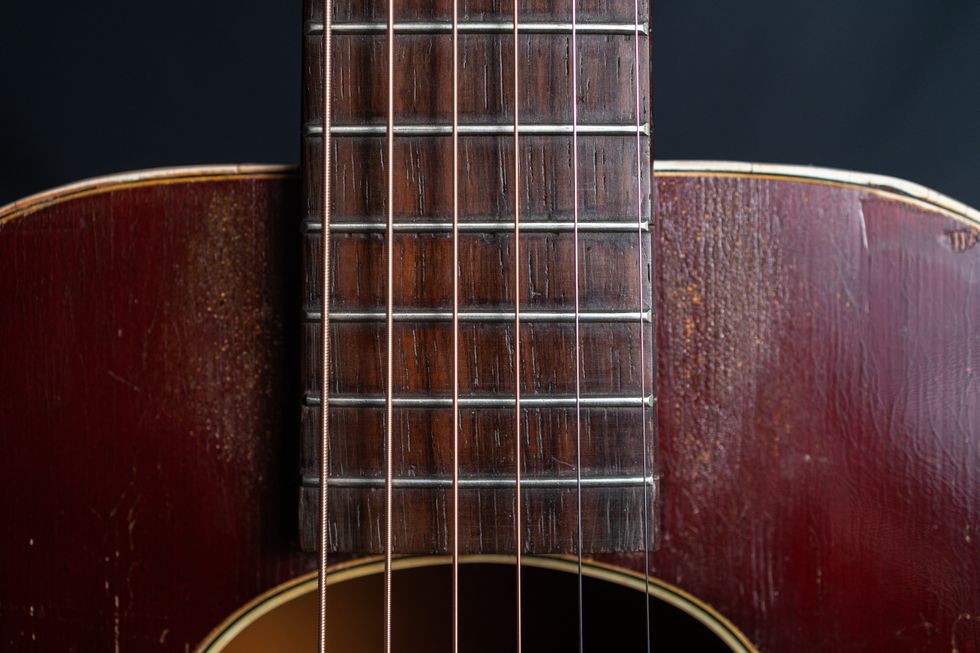
Time and wear have given this guitar a character as craggy as the old West.
Photo by Madison Thorn
The owners of Fanny’s, Pamela Cole and Leigh Maples, plopped it open on our front desk to page 106, where I read the history of Louise Massey and the Kay-made Montgomery Ward guitar that bears her name. Louise was known for her hit song “My Adobe Hacienda,” a beautiful tune calling back to the real heroes of cowboy culture, Mexican vaqueros. Her signature guitar was only made for a few short months in the fall of 1941, at the same time as our Carson Robison. As far as we know, it is the only cowboy guitar to feature a woman artist. Not even the Queen of the West, Dale Evans, had that honor!
This wonderful Kay acoustic took us on quite a journey. We love the stories in these old guitars, and we especially love seeing them write new stories with new owners. Sometimes all it takes is a neck set, and a little flattop like this one is all ready to inspire a new generation. Now, if you’ll excuse me, I must go scour eBay for a Louise Massey guitar.
The Accent vibrato, slash soundhole, and distinctive pickguard and control set make for an iconic and distinctive design.
Here’s how a cat named Capri, a German designer, and a whammy-bar inventor fit into the history of a maple-bodied marvel.
Here’s some Rickenbacker history you might enjoy—especially if you’re a fan of the company’s Fireglo works of art. F.C. Hall, the owner of Radio & Television Equipment Co. (Radio-Tel), purchased the Electro String Company from Adolph Rickenbacker in 1953. Hall revamped the business to focus on standard electric guitars rather than the steel guitars the company began producing in the early 1930s, such as the historic “Frying Pan” lap model.
These new electric guitars were slow sellers at first, but they continued to increase in popularity as the 1950s progressed. By early 1954, German guitar maker Roger Rossmeisl was hired as head of the woodshop, overseeing design and production. He concentrated on solidbody guitars for the first few years, giving them a unique European look that set Rickenbackers apart from other brands.
By 1958, Rossmeisl began work on a new group of semi-hollow electric guitars called the Capri Series (after Hall’s family cat). The series consisted of 12 models: the small-bodied three-quarter-sized 310, 315, 320, and 325; the standard full-sized 330, 335, 340, and 345; and the deluxe full-sized 360, 365, 370, and 375. Models ending in zero had no vibrato, while those ending in the number five did. The bodies for these guitars started as a solid block of wood, which was then hollowed out from the underside, with a separate back later attached. The vibrato-equipped instruments originally had Kauffman Vib-Rolas, but those were switched in 1960 to the more efficient Accent vibrato developed by Paul Butts, who also developed the Gibson Maestro Vibrola. By 1961, Rossmeisl had modified the original 2"-thick design to the 1 1/2" thickness that remains standard for the 330 series today.
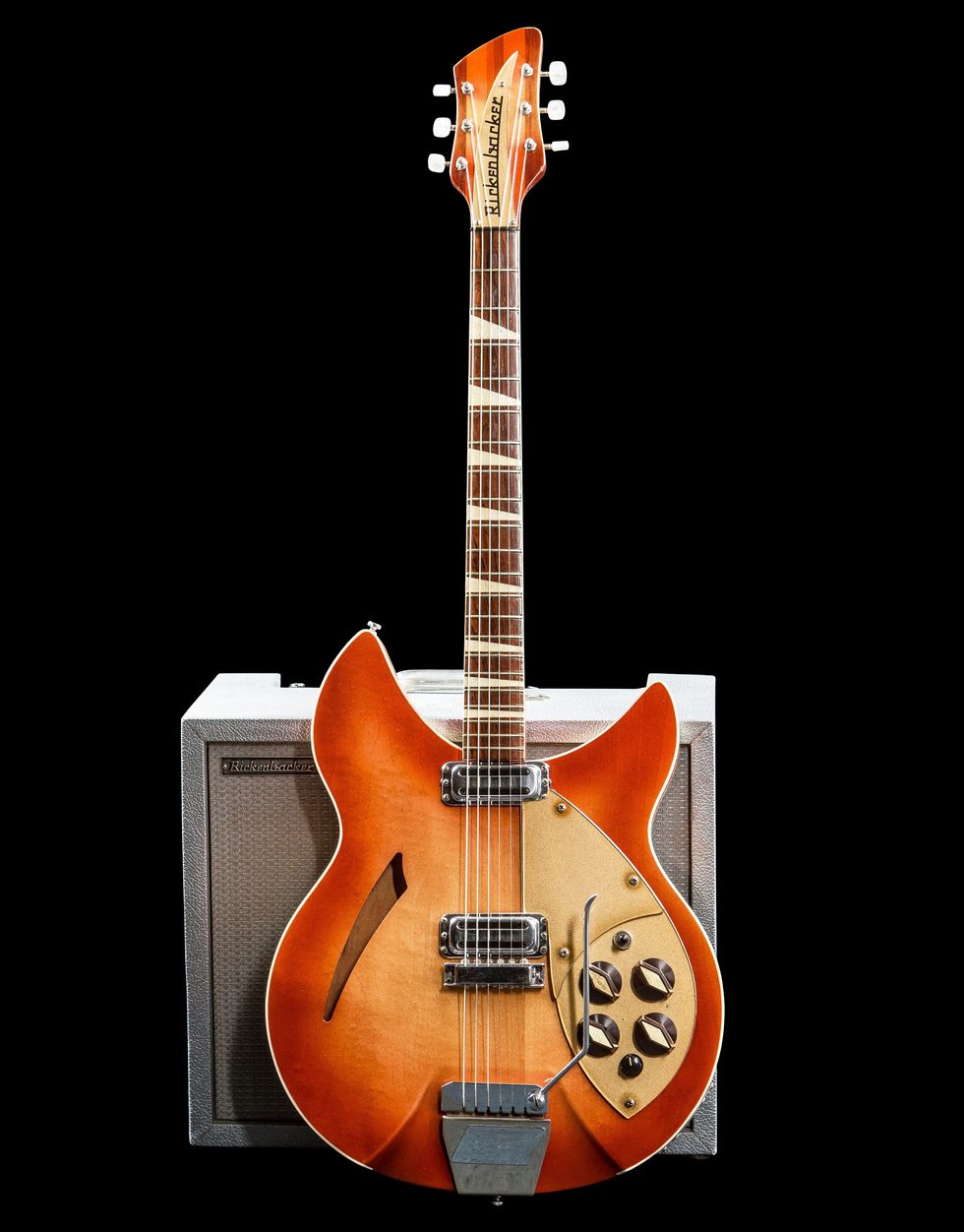
A potent tone combination: a 1963 Rickenbacker 365 with one of the company’s early 1960s B9A amps.
The 1963 guitar featured this month has the characteristics common to deluxe-series 365 models before they were reshaped again in 1964. These include a bound maple neck, a gloss-finished rosewood fretboard with large triangle-shaped inlays, two “toaster”-style single-coil pickups, a maple body with a bound top and back, a slash soundhole, and an Accent vibrato tailpiece.
This Fireglo finished guitar has a gold Lucite truss rod cover, with a matching two-layer pickguard (white plastic was used after 1963). Four diamond-shaped “oven” knobs control the volume and tone of each pickup, while the smaller blend control knob subtly balances the sound from each pickup when the switch is in the middle position. The original list price was $309.50. The current value for one in excellent, all-original condition is $5,000.
“The bodies for these guitars started as a solid block of wood, which was then hollowed out from the underside, with a separate back later attached.”
The amp behind the guitar is an early 1960s Rickenbacker B9A. It is equipped with tremolo, and pushes 6 watts through a 12" speaker. The current value for the amp is $700.
Sources for this article include Rickenbacker Electric 12-String: The Story of the Guitars, the Music, and the Great Players, by Tony Bacon; The History of Rickenbacker Guitars, by Richard R. Smith; The Rickenbacker Book: A Complete History of Rickenbacker Electric Guitars, by Tony Bacon and Paul Day; and Rickenbacker Guitars: Out of the Frying Pan into the Fireglo, by Martin Kelly and Paul Kelly.
With its block inlays, neck binding, adjustable bridge, and basic control set, this Ibanez 2662 looks ready to rock.
This Ibanez 2662 is an appealing, two-humbucker copycat design of a Ronnie Wood signature Greco rarity.
If you were to thumb through an Ibanez catalog from 1975, you’d see exactly why this period for the company and other guitar builders in Japan is known as the “lawsuit era.”
The guitars that dot the catalog’s pages look an awful lot like Gibsons, Fenders, and Rickenbackers. And these lookalikes are not mere homages inspired by classic shapes. Ibanez’s offerings represent very specific models within other brands’ then-current lineups. For example, its Les Paul-style guitars represent sunburst Standards, Customs with split-diamond headstock inlays, and even a ’70s oddity—the Les Paul Recording model.
But in Ibanez’s Custom Series, you’d see some designs you can't place so easily, including the 2662. An example of this rarity is now listed for sale on Reverb by the Austria-based Gregor Svend, and serves as the focus of this month’s column.
The 2662’s tulip-shaped body has some similarities to other Ibanez 26XX-series guitars, like the Artist Series 2680s and 2681s built for the Grateful Dead’s Bob Weir, yet the horns are nearly flattened. (At first, it appeared to us to be an original design, but thanks to a hawk-eyed reader, we now know the 2662 is based on the Greco RW-700, a Ron Wood Signature released the year prior.)
“By the 1976 catalog, the 2662 had disappeared completely. What a short, strange trip it must’ve been.”
In Ibanez’ 1975 Custom Series leaflet, where the 2662 made its first appearance, only its bare specs are shared: 41.5" total length, 17" x 13.75" body, Super-Humbucking pickups, a rosewood fretboard on a set neck, pearloid inlays, a brown sunburst finish, and gold hardware, including Smooth Tuners tuning pegs, a chunky bridge, and that wonderfully unique tailpiece. The control layout features two volume knobs, two tones, and a 3-way pickup selector switch.
But unlike those aforementioned Weir models, the 2662 did not catch on—perhaps because Ibanez didn’t really give it a chance. In the 1975 catalog, there is no price listed for the 2662. (Other 26XX guitars then available ranged between $391 and $631, with the 2662 likely landing on the higher end.) And by the 1976 catalog, the 2662 had disappeared completely. What a short, strange trip it must’ve been.
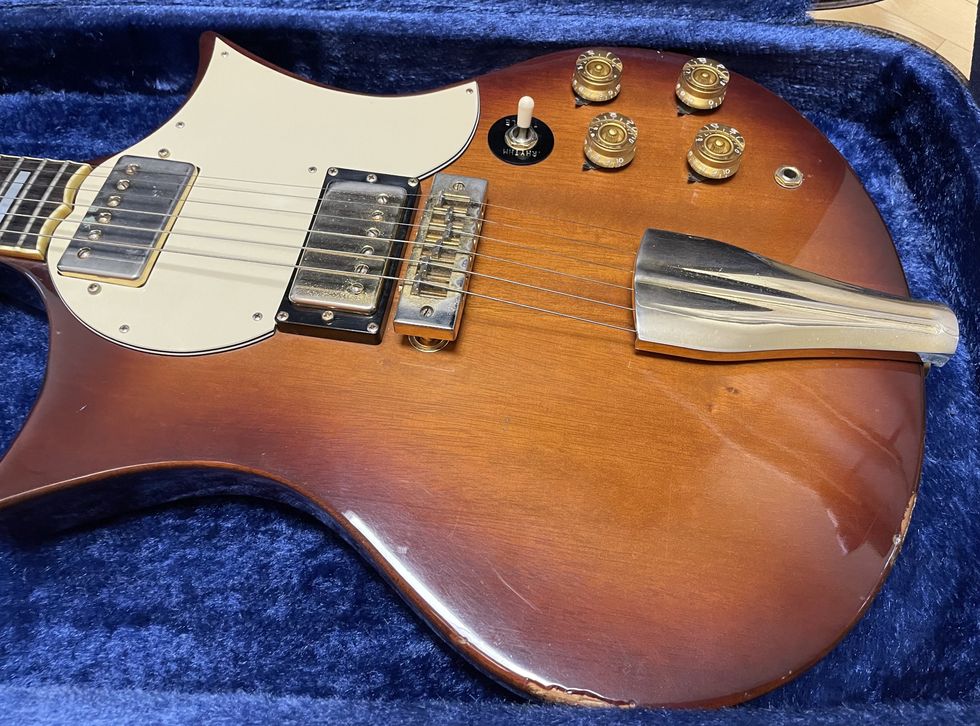
The pickup selector location could be easy to access or in the way, depending on a player’s right-hand approach, but the trapeze-type tailpiece invites some extended techniques on such a trimmed-down solidbody.
Exactly how many 2662s were ordered and built is not known, though they don’t pop up for sale very often. We’ve only seen two hit our site, and the other was not branded as Ibanez but as Mann, a brand name for a Canadian importer of Ibanez guitars in the ’70s. Fans of the guitar speculate that only a handful of 2662s exist, though that rarity has not led to astronomical asking prices when they do show up on the vintage market. We've seen exactly one Greco RW-700 change hands on Reverb, for the equivalent of roughly £1,300 (or a little more than $1,500).
This particular 2662 was originally listed for €3,800, but at the time of this writing had been price-dropped to €2,600 (or about $2,800). That new asking price is in line with the fancier of the two Weir-associated models (1970s 2681s average around $2,700) and a little less than the roughly $3,200 buyers spend, on average, for the Ibanez 2837CT, a korina V-style unveiled alongside the 2662 in Ibanez’s 1975 Custom Series.
Lawsuit-era guitars of all kinds seem to be getting more and more attractive to buyers, since they offer a relatively affordable entrypoint into the world of vintage guitar collecting. Can this column spark a revival for the obscure and cool 2662 (or, for that matter, the Greco RW-700)?
If a lawsuit-era guitar can command such interest, we wonder: Can this column help spark a revival for this obscure and cool Japanese original?
Sources: Ibanez catalogs from 1975 and 1976, Reverb listings, and Price Guide sales data.